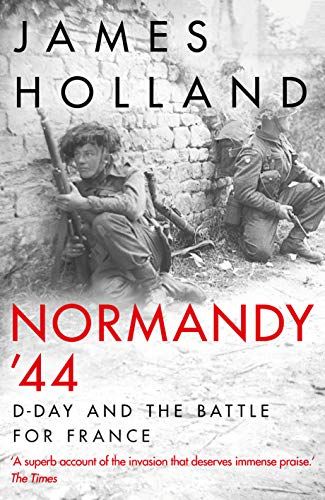Normandy '44: D-Day and the Battle for France - A New History
Renowned World War Two historian James Holland presents an entirely new perspective on one of the most important moments in recent history. Unflinchingly examining the brutality and violence that characterised the campaign, it's time to draw some radically different conclusions.
D-Day and the 76 days of bitter fighting in Normandy that followed have come to be seen as a defining episode in the Second World War. Its story has been endlessly retold, and yet it remains a narrative burdened by both myth and assumed knowledge. In this reexamined history, James Holland presents a broader overview, one that challenges much of what we think we know about D-Day and the Normandy campaign. The sheer size and scale of the Allies' war machine ultimately dominates the strategic, operational and tactical limitations of the German forces. This was a brutal campaign. In terms of daily casualties, the numbers were worse than for any one battle during the First World War.
Drawing on unseen archives and testimonies from around the world and ntroducing a cast of eye-witnesses that includes foot soldiers, tank men, fighter pilots and bomber crews, sailors, civilians, resistance fighters and those directing the action An epic telling that will profoundly recalibrate our understanding of its true place in the tide of human history.
D-Day, June 6, 1944, and the seventy-six days of bitter fighting in Normandy that followed the Allied landing, have become the defining episode of World War II in the west--the object of books, films, television series, and documentaries. Yet as familiar as it is, as James Holland makes clear in his definitive history, many parts of the OVERLORD campaign, as it was known, are still shrouded in myth and assumed knowledge. Drawing freshly on widespread archives and on the testimonies of eye-witnesses, Holland relates the extraordinary planning that made Allied victory in France possible; indeed, the story of how hundreds of thousands of men, and mountains of materiel, were transported across the English Channel, is as dramatic a human achievement as any battlefield exploit. The brutal landings on the five beaches and subsequent battles across the plains and through the lanes and hedgerows of Normandy--a campaign that, in terms of daily casualties, was worse than any in World War I--come vividly to life in conferences where the strategic decisions of Eisenhower, Rommel, Montgomery, and other commanders were made, and through the memories of paratrooper Lieutenant Dick Winters of Easy Company, British corporal and tanker Reg Spittles, Thunderbolt pilot Archie Maltbie, German ordnance officer Hans Heinze, French resistance leader Robert Leblanc, and many others.
For both sides, the challenges were enormous. The Allies confronted a disciplined German army stretched to its limit, which nonetheless caused tactics to be adjusted on the fly. Ultimately ingenuity, determination, and immense materiel strength--delivered with operational brilliance--made the difference. A stirring narrative by a pre-eminent historian, Normandy '44 offers important new perspective on one of history's most dramatic military engagements and is an invaluable addition to the literature of war.
| Author | James Holland |
|---|---|
| Publisher | Corgi Books |
| Place | London |
| Year | 2020 |
| ISBN | 9780552176118 |
| Binding | Paperback |
| Condition | Good |
| Comments | Slight curve in spine; film over covers peeling very slightly. |
How we describe the condition of our books
We are very proud of the condition of the books we sell (please read our testimonials to find out more!)
New: Exactly as it says.
As New: Pretty much new but shows small signs of having been read; inside it will be clean without any inscriptions or stamps; might contain a remainder mark.
Very Good: Might have some creases on the spine; no hard cracks; maybe slight forward lean and short inscription inside; perhaps very minor bumping on the corners of the book; inside clean but the page edges might be slightly yellowed.
Good: A few creases on the spine, perhaps a forward lean, bumping on corners or shelfwear; maybe an inscription inside or some shelfwear or a small tear or two on the dustjacket; inside clean but page edges might be somewhat yellowed.
Fair: In overall good condition, might have a severe forward lean to the spine, an inscription, bumping to corners; one or two folds on the covers and yellowed pages; in exceptional cases these books might contain some library stamps and stickers or have neat sticky tape which was used to fix a short, closed tear.
Poor: We rarely sell poor condition books, unless the books are in demand and difficult to find in a better condition. Poor condition books are still perfect for a good read, all pages will be intact and none threatening to fall out; most probably a reading copy only.


